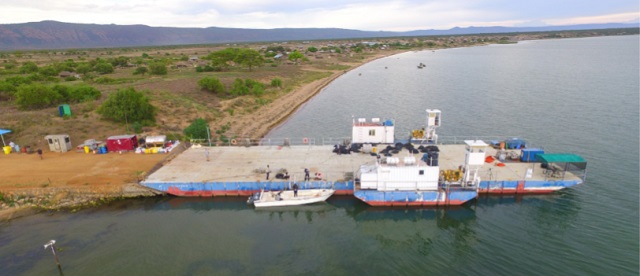
Government expects petroleum firm to expedite data processing and interpretation
Kampala, Uganda | RONALD MUSOKE | Nigerian firm, Oranto Petroleum Limited, has successfully completed its seismic data acquisition survey over the Ngassa block located near Uganda’s western border with the Democratic Republic of Congo.
A seismic survey is a technique usually done to explore and appraise oil and gas operations to get a clearer idea of the structures underneath the earth’s surface.
It involves the use of energy produced by instruments such as a seismic vibrator (onshore) or an air gun (in water) to generate waves that go through the earth’s layers and “bounce-back” from different rock layers. The reflected and refracted waves are then recorded by receivers (geophones on land or hydrophones in water) to produce the first image of the subsurface.
This technique is used to interpret what may lie underneath the ground or seabed (oil, gas, water, faults, and folds) without having to drill into the earth. The data acquired is then used by companies to make decisions of a suitable location where to drill a well.
Oranto contracted the UK-based IMC Geophysical Services Ltd to undertake the survey, which began in mid April this year and went on until May 18.
The Ngassa block lies on the eastern banks of Lake Albert, within the villages of Tonya A, Tonya B, Kijjangi, Mbegu, Kaiso and Kyehoro, in Hoima and Kikuube districts.
This block was initially part of Exploration Area 2 licensed to Tullow Uganda Operations Pty Limited but reverted to the government after the expiry of Tullow’s appraisal period.
Before Oranto’s exercise, 32 seismic surveys had been undertaken in the Albertine Graben, resulting in the acquisition of about 7,000-line kilometres of 2D seismic data and about 2,000 square kilometres of 3D seismic data. Two-dimensional seismic data displays a slice of the earth while 3D seismic data displays a three dimensional model of the subsurface.
Two-thirds of this block is covered by good quality 2D seismic data while the remaining third is covered by 3D seismic data acquired between 2003 and 2008.
The acquired data will be analysed together with the pre-existing 2D and 3D data to better define the north-eastern part of the Ngassa mega prospect.
“The survey involved the acquisition of 326 line kilometres of off shore (on Lake Albert) 2D seismic data over the Ngassa Contract Areas,” said Dozith Abeinomugisha, Director Exploration at the Petroleum Authority of Uganda (PAU).
Conclusion of this exercise represents an important step by the licensee in fulfilling its obligations for the first two-year exploration phase that runs from October 2017 to October 2019.”
The two stratigraphic licenses of Ngassa Deep Play and Ngassa Shallow Play Contract Areas were awarded to Oranto, 18 months ago by the Minister of Energy and Mineral Development, for a four-year period.
It was the first time Uganda undertook stratigraphic licensing, where two licenses are issued vertically over the same block.
Ministry of energy officials have in the past told The Independent that the move was intended to ensure that all potential oil and gas zones in the area are fully evaluated through implementation of work programmes approved by the Petroleum Authority of Uganda.
Oranto has also undertaken other technical studies as part of the exploration work programme, including reprocessing of the existing seismic data and petro-physical studies over the Ngassa 1 and 2 wells to evaluate the quality of the reservoir horizons penetrated by these wells.
According to energy ministry officials, the Ngassa prospect lies entirely under the lake, and as such, two deviated wells, Ngassa-1 and Ngassa-2, were drilled on land at the periphery of the main structure between 2007 and 2009 to access the reservoirs.
Although the two wells encountered oil and gas, much of this block was not tested, meaning that there was need for additional exploration work to fully assess the potential of the block.
Going forward, the government expects Oranto to process and interpret the acquired data whose results will inform the company’s subsequent activities over the next two years.
“We expect Oranto Petroleum Limited to revert to the PAU by October, 2019, with a detailed work programme for drilling at least one exploration well on Lake Albert within the next two years,” said Abeinomugisha.
Abdul Byakagaba Bazara, the General Manager of Oranto Petroleum Ltd described the exercise as a big success, thanking the government, security, local leaders and the communities in the area where the company operates.
Oranto has over the last 25 years undertaken oil and gas exploration mainly in West Africa and currently has exploration acreage in nine countries including; Equatorial Guinea, Benin, Ghana, Liberia, Namibia, Senegal, Sao Tome & Principe, Nigeria, South Sudan and Uganda.
****
 The Independent Uganda: You get the Truth we Pay the Price
The Independent Uganda: You get the Truth we Pay the Price




ORANTO IS TO DRILL A WELL BEFORE THE END OF ITS FIRST 4 YEAR NOT DECIDE AFTER 4 YEARS IF THEY MUST DRILL.
THIS IS THE CONTRACT AND LAW, IF THEY DO NOT DRILL BY OCTOBER 2021 THEN THE PAU HAS FAILED. THE PAU AND MINISTRY HAS NOT PROVIDED AN EXTENSION.
NGASSA IS A LITTLE AREA, NO NEED FOR 2 YEARS TO EVALUATE, THEY ARE WASTING TIME.
IF THEY DRILL AS YOU WANT, WITH FID IN PLACE AND EACOP IN PLACE … WHERE WILLYOU PUT THE DRILLLED OIL?